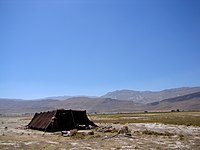
Photo from wikipedia
Background Rift Valley fever (RVF) is a vector-borne emerging zoonotic disease of animals and humans, characterized by socioeconomic losses to livestock farmers and global public health threat. The study determined… Click to show full abstract
Background Rift Valley fever (RVF) is a vector-borne emerging zoonotic disease of animals and humans, characterized by socioeconomic losses to livestock farmers and global public health threat. The study determined RVFV seroprevalence in cattle, assessed pastoralists’ knowledge about RVF, and factors that influence its occurrence in pastoral cattle herds of Nigeria. A cross-sectional study was conducted in pastoral herds of North-central Nigeria from 2017 to 2018. Data were collected using serology and questionnaire tools. Descriptive statistics were used to analyze the obtained data. Categorical variables were presented as proportions and their associations determined by Chi-square tests. Associations of risk factors were analyzed by univariable and multivariable logistic regressions analyses at 95% confidence level. Results The overall IgM seropositivity of RVFV in pastoral cattle herds was 5.6%. This was higher in nomadic herds (7.4%) than in agro-pastoral herds (3.8%). All animal demographic characteristics of age, sex and breeds were not significantly ( p > 0.05) associated with RVFV occurrence in pastoral herds. All the 403 pastoralists selected participated in the study, with the majorities of them being male, married and have no formal education. Majority of the pastoralists had low knowledge levels about zoonotic RVFV infection. All identified socio-ecological factors significantly ( p < 0.05) influenced RVFV occurrence in herds. Mosquitoes availability in cattle environment (OR = 7.81; 95% CI: 4.85, 12.37), presence of rivers and streams at grazing fields (OR = 10.80; 95% CI: 6.77, 17.34), high rainfall (OR = 4.30; 95% CI: 2.74, 6.59), irrigated rice fields (OR = 5.14; 95% CI: 3.21, 7.79) , bushy vegetation (OR = 6.11; 95% CI: 3.96, 9.43), animal movement (OR = 2.2; 95% CI: 1.45, 3.25), and seasons (OR = 2.34; 95% CI: 1.55, 3.51) were more likely to influenced RVFV occurrence in cattle herds. Conclusions Results of this study had illustrated recent circulation of RVFV in pastoral cattle herds in Nigeria and needs urgent interventions. The surveyed pastoralists had low knowledge level about RVF while the socio-ecological factors significantly influenced RVFV occurrence in herds. To address these gaps, pastoralists should be educated on clinical manifestations and modes of transmission of the disease in animals and humans, and mitigation measures. Adequate knowledge about RVF epidemiology will assure food security and public health.
Journal Title: BMC Veterinary Research
Year Published: 2020
Link to full text (if available)
Share on Social Media: Sign Up to like & get
recommendations!